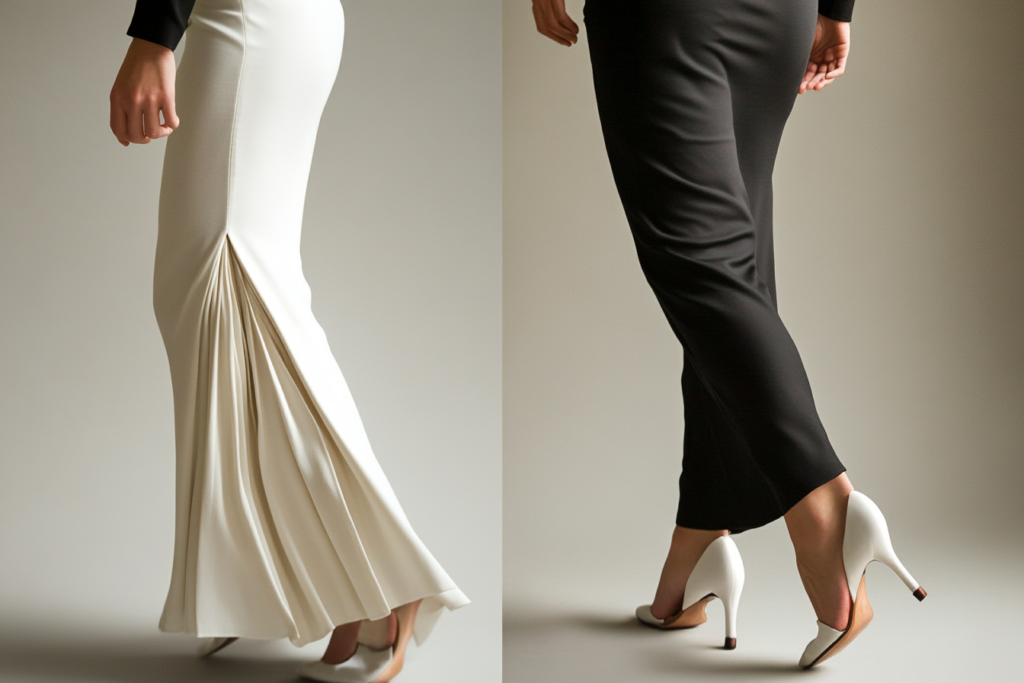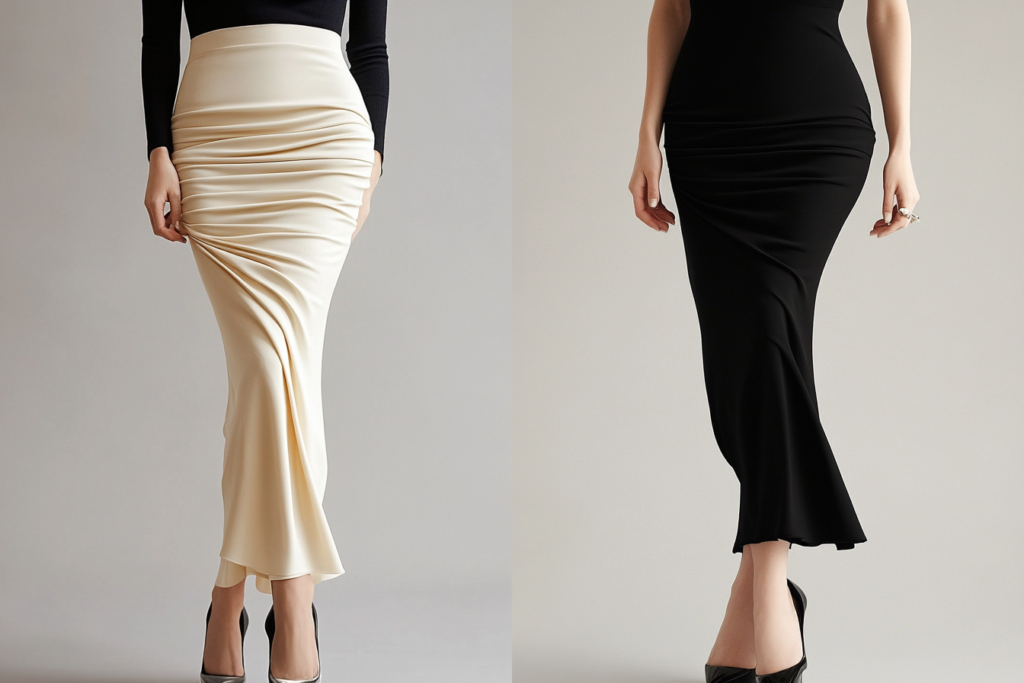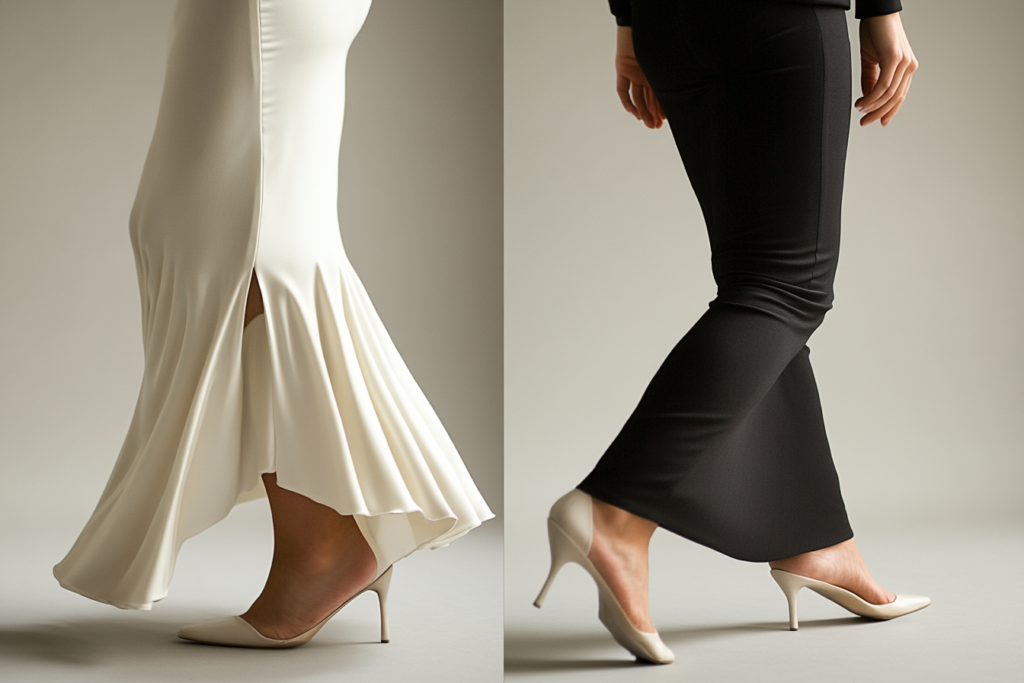Hobble Skirt: The Narrow-Hemmed Skirt That Revolutionized Fashion
Meta Description: The hobble skirt, popularized by Paul Poiret in the 1910s, features a narrow hem that restricts movement, creating a dramatic silhouette. Learn about its history, design, and modern adaptations.
What is a Hobble Skirt?
A hobble skirt is a long, fitted skirt with an extremely narrow hem, restricting the wearer’s stride and movement. The term “hobble” comes from the fact that the tight hem forced women to take small, careful steps.
This dramatic and restrictive design was popularized by French designer Paul Poiret in the 1910s, challenging traditional fashion norms and paving the way for modern sleek and body-conscious silhouettes.


Key Features of the Hobble Skirt
✔ Narrow, Constricting Hem – Limits movement, creating a restricted yet elegant stride.
✔ High Waistline – Often fitted at the waist and hips for a streamlined shape.
✔ Long Length – Typically ankle-length or floor-length, emphasizing vertical lines.
✔ Luxurious Fabrics – Made from silk, satin, velvet, or lightweight wool, reflecting early 20th-century elegance.
✔ Historical Influence – Inspired by Edwardian-era corsetry and Japanese kimono aesthetics.
The History of the Hobble Skirt
1. Paul Poiret and the Rise of the Hobble Skirt (1910s)
Paul Poiret, a visionary French couturier, introduced the hobble skirt as a radical departure from traditional, heavily layered Edwardian fashion.
- He eliminated the corset but replaced it with a constricting skirt.
- Poiret’s designs were influenced by Eastern aesthetics, including kimono-like draping and tunic-style tops.
- The hobble skirt became a symbol of modernity and high fashion, worn by wealthy women and socialites.
2. Practical Issues & Decline (1914–1920s)
- The skirt’s tight hem severely limited movement, making it impractical for daily wear.
- Women had to take tiny, restricted steps, sometimes needing hobble garters (straps at the knees) to prevent tearing the fabric.
- By World War I (1914–1918), practicality took precedence, and looser skirts and shorter hemlines replaced the hobble skirt.
3. The Hobble Skirt’s Legacy in Fashion
Though short-lived, the hobble skirt influenced future fashion trends, including:
- 1920s drop-waist dresses with long, slim silhouettes.
- 1930s and 1940s pencil skirts that emphasized sleek lines.
- Modern mermaid skirts and fitted gowns seen in eveningwear today.
Modern Interpretations of the Hobble Skirt
While the original hobble skirt is no longer practical, its influence is visible in contemporary fashion, including:
✔ Mermaid Gowns & Trumpet Skirts – Fitted through the hips and thighs, flaring below the knees.
✔ Bodycon & Pencil Skirts – Slim-fitting skirts inspired by the restrictive elegance of the hobble skirt.
✔ High-Fashion Runway Looks – Designers like Alexander McQueen, Dior, and Jean Paul Gaultier have referenced hobble-style silhouettes in their collections.
✔ Vintage-Inspired Eveningwear – Modern recreations for historical fashion enthusiasts and retro lovers.
How to Wear a Hobble Skirt-Inspired Look Today
🖤 For Formal Events – Choose a mermaid or fishtail gown to recreate the dramatic, elongated silhouette.
🖤 For Vintage Glamour – A pencil skirt with a high waist and pointed heels gives a refined, 1910s-inspired vibe.
🖤 For a Modern Edge – Try a narrow-cut midi skirt paired with a structured top or corset.
Hobble Skirt vs. Pencil Skirt: What’s the Difference?
| Feature | Hobble Skirt | Pencil Skirt |
|---|---|---|
| Hemline | Extremely narrow, restricting movement | Narrow but allows walking ease |
| Length | Floor-length or ankle-length | Knee-length or midi |
| Historical Influence | Early 1910s fashion | 1940s–50s sleek silhouettes |
| Wearability | Highly restrictive | Comfortable for everyday wear |
While the hobble skirt was extreme, the pencil skirt became a more practical alternative, keeping the sleek silhouette while allowing ease of movement.
Why is the Hobble Skirt Significant in Fashion History?
✔ Challenged Edwardian Fashion Norms – Introduced a new, modern silhouette.
✔ Symbolized Luxury & Exclusivity – Worn by high-society women and fashion-forward elites.
✔ Influenced Future Trends – Inspired body-hugging skirts and gowns.
✔ Showcased Paul Poiret’s Innovation – A turning point in early 20th-century haute couture.
Conclusion: The Enduring Legacy of the Hobble Skirt
Though the hobble skirt was a short-lived trend, its influence is still seen in today’s fashion. It represented innovation, elegance, and the changing role of women in society. While we no longer restrict our movement with tight hems, the desire for a sleek, sophisticated silhouette continues to inspire designers today.
From Paul Poiret’s bold 1910s creations to modern red carpet gowns, the hobble skirt remains a fascinating chapter in fashion history.



